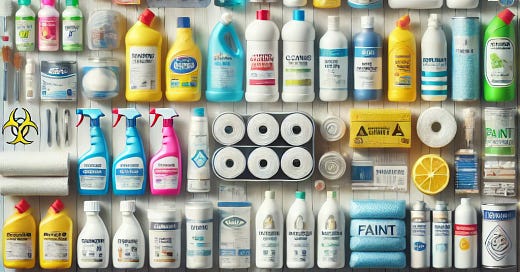Chemicals
TLDR - Chemicals found in everyday products like personal care products, cleaning supplies, fabrics, and building materials can cause a danger response in the body.
Expanded
Personal Care Products: Many personal care products, such as shampoos, lotions, and cosmetics, contain chemicals like parabens, phthalates, and formaldehyde. Parabens are preservatives that can mimic estrogen, potentially disrupting hormonal balance and increasing the risk of breast cancer. Phthalates, often used to make plastics more flexible, can interfere with the endocrine system, affecting reproductive health and development. Formaldehyde, a known carcinogen, can be found in hair treatments and nail polish, posing risks of cancer and allergic reactions. Etc.
Household Cleaning Products: The chemicals in household cleaning products, including bleach, ammonia, and various solvents, are designed to kill germs and remove stains. Inhalation of these chemicals can lead to respiratory issues, skin irritation, and in severe cases, poisoning. Long term exposure to these chemicals has been linked to chronic respiratory problems and even cancer.
Food and Food Packaging: Processed foods and their packaging often contain chemicals like preservatives, artificial colors, and BPA. Preservatives such as nitrates and nitrites can form carcinogenic compounds in the body, increasing the risk of cancer. Artificial colors and flavors have been linked to hyperactivity and behavioral issues in children. BPA, found in plastic containers and canned food linings, can disrupt hormonal functions and has been associated with heart disease, diabetes, and developmental problems.
Home Improvement Products: Paints, varnishes, and adhesives used in home improvement projects can release volatile organic compounds (VOCs) into the air. VOCs can cause short term health effects like headaches, dizziness, and respiratory irritation. Long term exposure has been linked to liver and kidney damage, nervous system issues, and cancer. There are low VOC and VOC free options that should be used when possible.
Electronics and Gadgets: Electronics contain various harmful substances, including lead, mercury, and brominated flame retardants. Lead exposure can lead to neurological damage, particularly in children, affecting their cognitive development and causing behavioral problems. Mercury can harm the nervous, digestive, and immune systems, and brominated flame retardants have been linked to hormone disruption and impaired brain development.
Automotive Products: Automotive products such as motor oils, antifreeze, and brake fluids contain chemicals that can be hazardous if mishandled. These substances can cause skin and eye irritation, respiratory issues, and poisoning if ingested. Prolonged exposure to these chemicals has been linked to organ damage and cancer.
Children’s Products: Toys, cribs, and baby bottles may contain harmful chemicals like lead, phthalates, and BPA. Lead exposure can result in developmental delays and learning difficulties in children. Phthalates and BPA can disrupt hormone function and affect growth and development.
Textiles and Fabrics: Clothing, bedding, and upholstery can be treated with chemicals for durability, stain resistance, and flame retardancy. These chemicals, including formaldehyde and flame retardants, can off gas into the air, leading to respiratory issues, skin irritation, and an increased risk of cancer.
Office Supplies: Items such as printer inks, toners, and permanent markers can emit toxic fumes that pose health risks. Inhalation of these fumes can cause headaches, respiratory problems, and eye irritation. Long term exposure may contribute to more serious health issues, including organ damage and cancer.
The list is endless:
Personal Care Products:
Shampoos
Conditioners
Body washes
Lotions
Deodorants
Makeup and cosmetics
Nail polish and removers
Hair dyes and treatments
Sunscreens
Fragrances and perfumes
Household Cleaning Products:
All purpose cleaners
Disinfectants
Laundry detergents
Fabric softeners
Bleach
Toilet bowl cleaners
Oven cleaners
Floor cleaners
Air fresheners and deodorizers
Pesticides and Insecticides:
Bug sprays
Ant traps
Rodent poisons
Weed killers
Fungicides
Food and Food Packaging:
Processed foods with preservatives
Food coloring and additives
Plastic containers and wraps (BPA, phthalates)
Canned foods (BPA in linings)
Microwave popcorn bags
Non stick cookware (PFOA)
Home Improvement Products:
Paints and paint thinners
Varnishes and stains
Adhesives and glues
Insulation materials
Carpets and rugs (formaldehyde)
Furniture and upholstery (flame retardants)
Electronics and Gadgets:
Computers and laptops
Mobile phones and tablets
Televisions and monitors
Cables and wires (PVC)
Automotive Products:
Motor oils and lubricants
Antifreeze
Brake fluids
Car waxes and polishes
Tire cleaners
Children's Products:
Toys (lead, phthalates)
Cribs and mattresses (flame retardants)
Baby bottles and sippy cups (BPA and other plastics)
Children's cosmetics and face paints
Textiles and Fabrics:
Clothing (pesticides, formaldehyde)
Bedding and linens (chemical finishes)
Curtains and drapes (fire retardants)
Office Supplies:
Printer inks and toners
Correction fluids
Permanent markers
Adhesive tapes
The list of harms are endless. Ultimately, the chemical is causing a danger response somewhere in your body. It is important to rid yourself of the chemical, detox, and to stop the danger response.
Also note that many of these chemicals are unavoidable in our modern world. While it’s important to be aware of them and make efforts to minimize exposure, it’s also important to stay calm and trust that your body has natural pathways to protect itself from these substances.
Natural Alternatives
Vinegar: A versatile and effective cleaner, vinegar can be used to clean surfaces, windows, and mirrors. It also works well as a natural fabric softener and deodorizer in the laundry.
Baking Soda: Great for scrubbing surfaces, deodorizing carpets, and as a gentle abrasive for cleaning pots and pans.
Lemon Juice: Its natural acidity makes lemon juice effective at cutting through grease and removing stains. It also leaves a fresh, natural scent.
Castile Soap: A biodegradable and non toxic soap that can be used for cleaning dishes, floors, and even as a body wash.
Essential Oils: Oils like tea tree, lavender, and eucalyptus have natural antibacterial properties and can be added to cleaning solutions for extra disinfecting power.



